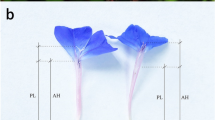Abstract
Heterostyly rarely occurs in families with strongly zygomorphic flowers. For this reason Darwin (1877) doubted whether heterostyly would occur in the Lamiaceae and recent reviews have not reported the floral polymorphism in this family. Here we describe distyly in a rare species ofSalvia restricted to bluffs and seaward canyons on Santa Rosa Island (Santa Barbara Co., California) and northwestern Baja California (Mexico).Salvia brandegeei is morphologically distylous with populations composed of equal frequencies of long-and short-styled morphs differing reciprocally in stigma and anther position. Controlled hand pollinations demonstrated no significant differences in the seed set of self, intramorph or intermorph pollinations. Unlike most heterostylous species investigated,S. brandegeei does not possess diallelic incompatibility or ancillary polymorphisms of pollen and stigmas. We propose that the evolution of distyly inS. brandegeei may have been associated with an ecological shift to a new environment in which protandry failed to prevent increased levels of geitonogamy. Heterostyly was then selected because it increased the proficiency of cross-pollination. The origin of distyly in self-compatibleS. brandegeei is consistent with Lloyd and Webb's theoretical model for the evolution of distyly.
Similar content being viewed by others
References
Anderson W. R. (1973) A morphological hypothesis for the origin of heterostyly in the Rubiaceae. Taxon 22: 537–542.
Baker A. M., Thompson J. D., Barrett S. C. H. (2000) Evolution and maintenance of stigmaheight dimorphism in Narcissus: I. Floral variation and style-morph ratios. Heredity (in press).
Barrett S. C. H. (ed.) (1992a) Evolution and function of heterostyly. Springer, Berlin.
Barrett S. C. H. (1992b) Heterostylous genetic polymorphisms: model systems for evolutionary analysis. In: Barrett S. C. H. (ed.) Evolution and function of heterostyly. Springer, Berlin, pp. 1–29.
Barrett S. C. H., Cruzan M. B. (1994) Incompatibility in heterostylous plants. In: Williams E. G., Clarke A. G., Knox R. B. (eds.) Genetic control of self-incompatibility and reproductive development in flowering plants. Kluwer Academic Publishers, Dordrecht, pp. 189–219.
Barrett S. C. H., Richards J. H. (1990) Heterostyly in tropical plants. Mem. N. Y. Bot. Gard. 55: 35–61.
Barrett S. C. H., Cole W. W., Arroyo J., Cruzan M. B., Lloyd D. G. (1997) Sexual polymorphisms inNarcissus triandrus (Amaryllidaceae): Is this species tristylous? Heredity 78: 135–145.
Charlesworth D., Charlesworth B. (1979) A model for the evolution of distyly. Amer. Natur. 114: 467–498.
Cochrane S. A., Day A. G. (1994) A heterostylousGilia (Polemoniaceae) from central Nevada. Madroño 41: 120–127.
Darwin C. (1877) The different forms of flowers on plants of the same species. John Murray, London.
Dulberger R. (1992) Floral polymorphisms and their functional significance in the heterostylous syndrome. In: Barrett S. C. H. (ed.) Evolution and function of heterostyly. Springer, Berlin, pp. 41–84.
Epling C. C. (1938) The Californian Salvias: A review ofSalvia sectionAudibertia. Ann. Missouri Bot. Gard. 25: 95–188.
Epling C. C. (1940) Supplementary notes onSalvia:Audibertia. Ann. Missouri Bot. Gard. 27: 259–263.
Ganders F.R. (1978) The genetics and evolution of gynodioecy inNemophila menziesii (Hydrophyllaceae). Can. J. Bot. 56: 1400–1408.
Ganders F. R. (1979) The biology of heterostyly. New Zeal. J. Bot. 17: 607–635.
Goldblatt P., Bernhardt P. (1990) Pollination biology ofNivenia (Iridaceae) and the presence of heterostylous self-compatibility. Israel J. Bot. 39: 93–111.
Haque Md. S., Ghoshal K. K. (1981) Floral biology and breeding system in the genusSalvia L. Proc. Indian Natn. Sci. Acad. B47: 716–724.
Harder L. D., Barrett S. C. H. (1996) Pollen dispersal and mating patterns in animal-pollinated plants. In: Lloyd D. G., Barrett S. C. H. (eds.) Floral biology: studies on floral evolution in animal-pollinated plants. Chapman and Hall, New York, pp. 140–190.
Harder L. D., Barrett S. C. H., Cole W. W. (2000) The mating consequences of sexual segregation within inflorescences of flowering plants. Proc. R. Soc. Lond. B. 267: 315–320.
Huck R. B. (1992) Overview of pollination biology in the Lamiaceae. In: Harley R. M., Reynolds T. (eds.) Advances in Labiate science. The Royal Botanic Gardens Kew, Richmond, UK, pp. 167–182.
Leppik E. E. (1972) Origin and evolution of bilateral symmetry in flowers. Evolutionary Biology 5: 49–72.
Lloyd D. G., Webb C. J. (1986) The avoidance of interference between the presentation of pollen and stigmas in angiosperms. I. Dichogamy. New Zeal. J. Bot. 24: 135–162.
Lloyd D. G., Webb C. J. (1992a) The evolution of heterostyly. In: Barrett S. C. H. (ed.) Evolution and function of heterostyly. Springer, Berlin, pp. 151–178.
Lloyd D. G., Webb C. J. (1992b). The selection of heterostyly. In: Barrett S. C. H. (ed.) Evolution and function of heterostyly. Springer, Berlin, pp. 179–208.
Mabberley D. J. (1987) The plant book. Cambridge University Press, Cambridge.
Navarro L. (1997) Is the dichogamy ofSalvia verbenacea (Lamiaceae) an effective barrier to self-fertilization? Plant Syst. Evol. 207: 111–117.
Neisess K. R. (1984) Heterostyly inSalvia brandegeei (Lamiaceae). Madroño 31: 253–254.
Ornduff R. (1971) The reproductive system ofJepsonia heterandra. Evolution 25: 300–311.
Ornduff R. (1979a) Heterostyly inOplonia (Acanthaceae). J. Arnold Arboretum 60: 382–385.
Ornduff R. (1979b) The genetics of heterostyly inHypericum aegypticum. Heredity 42: 271–272.
Owens S. J., Ubera-Jiménez J. L. (1992) Breeding systems in Labiatae. In: Harley R. M., Reynolds T. (eds.) Advances in Labiate science. The Royal Botanic Gardens Kew, Richmond, UK, pp. 257–280.
Proctor M., Yeo P., Lack A. (1996) The natural history of pollination. Timber Press, Portland, USA.
Richards A. J. (1997) Plant breeding systems. Second edn. Chapman & Hall, London.
Richards J. H., Koptur S. (1993) Floral variation and distyly inGuettarda scabra (Rubiaceae). Amer. J. Bot. 80: 31–40.
SAS Institute (1994) JMP Users' Guide Version 3.0.2. SAS Institute, Cary, NC.
Van Treuren R., Bijlsma R., Ouborg N. J., Van Delden W. (1993) The effect of population size and plant density on outcrossing rate in locally endangeredSalvia pratensis. Evolution 47: 1094–1104.
Vuilleumier B. S. (1967) The origin and evolutionary development of heterostyly in the angiosperms. Evolution 21: 210–226.
Author information
Authors and Affiliations
Rights and permissions
About this article
Cite this article
Barrett, S.C.H., Wilken, D.H. & Cole, W.W. Heterostyly in the Lamiaceae: The case ofSalvia brandegeei . Pl Syst Evol 223, 211–219 (2000). https://doi.org/10.1007/BF00985280
Received:
Accepted:
Issue Date:
DOI: https://doi.org/10.1007/BF00985280




